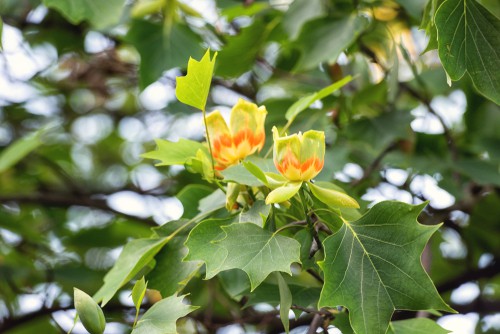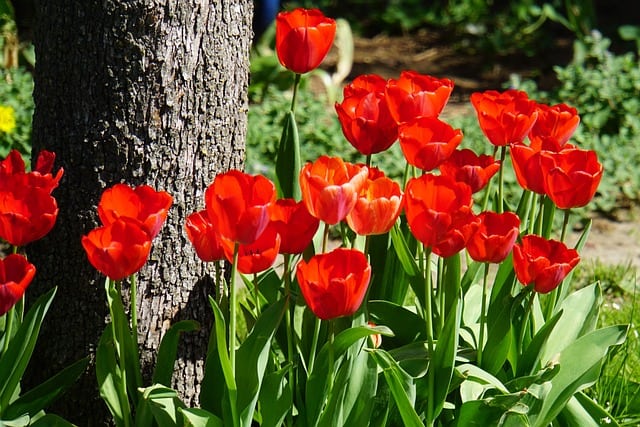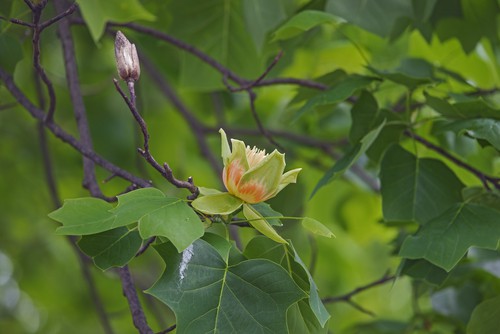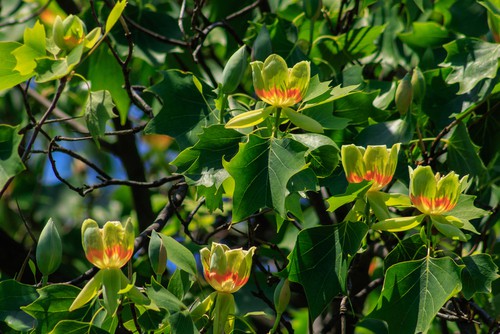Tulip trees are known for their beauty and vibrant green foliage, but what happens when the leaves start turning brown? This is a common problem that many gardeners and homeowners face, and it can be caused by a variety of factors. Understanding tulip tree leaves turning brown is crucial in preventing and treating the issue.
There are several common causes of brown leaves on tulip trees, including fungal infections, environmental stress, and insect infestations. Fungal infections, such as leaf spot, can cause brown spots on the leaves and eventually lead to defoliation.
Environmental stress, such as drought or excessive watering, can also cause the leaves to turn brown. Insect infestations, such as aphids or spider mites, can cause yellowing and browning of the leaves.
Preventive measures and treatment options are available to help address the issue of brown leaves on tulip trees. Proper care and maintenance, such as regular watering and fertilization, can help prevent fungal infections and environmental stress.
Insecticides and other treatments can be used to control insect infestations. Identifying and understanding tulip trees, as well as the impact of location on their growth, can also help prevent brown leaves from occurring.
Key Takeaways
- Brown leaves on tulip trees can be caused by fungal infections, environmental stress, and insect infestations.
- Proper care and maintenance, as well as the use of insecticides and other treatments, can help prevent and treat brown leaves.
- Understanding tulip trees and their specific care needs, as well as the impact of location on their growth, is crucial in preventing brown leaves.
Also don’t miss:
- Tree Leaves Turning Brown Early
- Tips of Snake Plant Turning Brown
- Tips of Orchid Leaves Turning Brown
Understanding Tulip Tree Leaves Turning Brown

Tulip trees, also known as Liriodendron tulipifera, are deciduous trees that are native to North America. They are known for their beautiful tulip-shaped flowers, which bloom in the spring and summer. However, if you notice that the leaves on your tulip tree are turning brown, it could be a sign of a problem.
There are several reasons why tulip tree leaves may turn brown. One of the most common causes is environmental stress. This can be caused by a lack of water, too much water, or extreme temperatures.
If the leaves on your tulip tree are turning brown, it is important to check the soil moisture level and make sure that the tree is not being over or under-watered.
Another possible cause of brown leaves on a tulip tree is disease. One common disease that affects tulip trees is called verticillium wilt. This disease is caused by a fungus that attacks the tree’s roots and causes the leaves to turn brown and wilt.
If you suspect that your tulip tree has verticillium wilt, it is important to contact a professional arborist to assess the situation and determine the best course of action.
In addition to environmental stress and disease, brown leaves on a tulip tree can also be caused by pests. One common pest that affects tulip trees is called the tulip tree scale. This insect feeds on the sap of the tree and can cause the leaves to turn brown and wilt.
If you suspect that your tulip tree has a pest infestation, it is important to contact a professional arborist to assess the situation and determine the best course of action.
Tulip Tree Leaves Turning Brown – 3 Common Problems
Tulip tree owners may notice their tree’s leaves turning brown, which can be concerning. The following are some of the most common causes of browning leaves on tulip trees.
1. Watering Issues
Overwatering or underwatering can cause tulip tree leaves to turn brown. If the tree is getting too much water, the leaves may turn yellow before turning brown.
On the other hand, insufficient watering can cause the leaves to dry out and turn brown. It is important to ensure that the tree is getting the appropriate amount of water, especially during hot, dry weather.
2. Disease and Pests

Tulip trees can be susceptible to various diseases and pests, which can cause the leaves to turn brown. Root rot is a common disease that can cause brown spots on the leaves, while black fungus and bacterial infections can cause the leaves to turn black. Pests such as spider mites and aphids can also cause brown spots on the leaves.
3. Environmental Factors
Environmental factors such as high winds, freezing temperatures, and insufficient watering can cause tulip tree leaves to turn brown. In the spring, frost damage can also cause brown leaves to appear temporarily.
In the summer, inadequate watering or high winds may be the cause of browning leaves. Sorting out exactly what’s going on is key to finding the right solution.
It is important to note that location can also play a role in browning leaves. Tulip trees prefer well-draining soil and full sun, so planting the tree in an area with poor drainage or insufficient sunlight can cause the leaves to turn brown.
Preventive Measures and Treatment
1. Proper Watering
One of the most common reasons for tulip tree leaves turning brown is over-watering. To prevent this, it is crucial to water the tree properly. The tree should be watered deeply but infrequently. The frequency of watering depends on the weather and soil moisture.
In general, the tree should be watered once a week in the absence of rainfall. The water should be applied slowly to allow it to penetrate deeply into the soil.
2. Pest and Disease Management
Tulip trees are susceptible to various pests and diseases that can cause the leaves to turn brown. One of the most common diseases is Verticillium wilt. This disease can be prevented by planting disease-resistant cultivars and avoiding planting the tree in soil that has been previously infected.
If the tree is infected, it should be treated with a fungicide.
Another common disease is Botrytis, or tulip fire. This fungal disease can be prevented by proper sanitation practices, such as removing diseased plant parts, cutting off the diseased roots and leaves, and repotting the plant in sterile potting soil. If the disease persists, a fungicide can be used.
3. Environmental Control

Tulip trees require a specific environment to thrive. They prefer well-drained soil and full sun exposure. To prevent the leaves from turning brown, it is important to plant the tree in a suitable location.
The tree should be planted in a location that receives full sun exposure and has well-drained soil. The soil should be amended with compost and mulched to retain moisture.
Proper pruning can also help prevent the leaves from turning brown. Dead or diseased branches should be removed promptly to prevent the spread of disease. The tree should be pruned in late winter or early spring before new growth appears.
An irrigation system can also be used to prevent the leaves from turning brown. The system should be set up to water the tree deeply but infrequently. The soil moisture should be monitored regularly to ensure that the tree is not over-watered.
Specific Care for Tulip Trees
1. Planting and Soil Requirements
Tulip trees prefer well-drained soil that is rich in organic matter. They grow best in loamy soil that is slightly acidic with a pH range of 5.0 to 8.0.
When planting tulip trees, it is important to ensure that the soil is not compacted and that it drains well. If the soil is heavy clay, it may be necessary to amend it with compost or potting soil to improve drainage.
Bark mulch or wood chips can be used to protect the shallow roots of young tulip trees and help to keep the soil moist. When planting, it is important to choose a location that receives full sun for optimal growth. Tulip trees can tolerate high humidity but may not grow as well in areas with poor air circulation.
2. Seasonal Care
Tulip trees require regular watering, especially during the first few years after planting. During periods of drought, it may be necessary to water the tree deeply once a week. In the fall, it is important to rake up and dispose of fallen leaves to prevent the spread of diseases such as leaf spot.
In the winter, it is important to protect young trees from frost damage by wrapping the trunk with burlap or other protective material. In the spring, it is important to prune any dead or damaged branches to promote healthy growth.
3. Handling Pests and Diseases
Tulip trees are generally resistant to pests and diseases, but they can be affected by certain fungal diseases such as verticillium wilt and leaf spot. If brown spots appear on the leaves, it may be a sign of leaf spot disease. To prevent the spread of the disease, it is important to remove and dispose of infected leaves and branches.
Insect pests such as aphids and scale can also affect tulip trees. These pests can be controlled with insecticidal soap or horticultural oil. It is important to follow the instructions on the label when applying these products to prevent damage to the tree.
Identifying and Understanding Tulip Trees

Botanical Information
Tulip trees, also known as Liriodendron tulipifera, are deciduous trees native to eastern North America. They are part of the magnolia family and can grow up to 100 feet tall.
Tulip trees have distinctive leaves that are four-lobed and resemble tulip flowers. The leaves can grow up to 8 inches long and wide, and they turn yellow in the fall. Tulip trees produce flowers in the spring that are yellow-green with an orange band at the base. The flowers are shaped like tulips and can grow up to 2 inches in diameter.
Recognizing Common Diseases
Tulip trees are susceptible to several diseases, including fungal conditions that can cause the leaves to turn brown and brittle. One common fungal condition is Verticillium wilt, which causes wilting and death of leaves on the tree.
Another fungal condition is Cercospora leaf spot, which causes brown spots on the leaves. Overwatering can also cause brown spots on the leaves, as well as root rot, which can lead to the death of the tree.
It is important to identify and treat diseases early to prevent them from spreading and causing serious damage to the tree. If you notice brown spots on the leaves or other signs of disease, it is best to consult with a professional arborist or horticulturist to determine the best course of action.
The Impact of Location on Tulip Trees
Tulip Trees in Eastern North America
Tulip trees are native to the eastern part of North America and are commonly found in forests, parks, and along roadsides. They are known for their tall, straight trunks and showy yellow flowers that bloom in the spring. Tulip trees are deciduous, which means they lose their leaves in the fall and grow new ones in the spring.
The climate in eastern North America is generally favorable for tulip trees, as they prefer moist, well-drained soil and moderate temperatures. However, extreme weather events such as droughts or floods can have a negative impact on the health of tulip trees.
State Trees: Kentucky, Tennessee, and Indiana

Tulip trees are the state trees of Kentucky, Tennessee, and Indiana. They are highly valued for their timber, which is used for furniture, flooring, and other construction materials. The use of tulip tree wood is regulated by state and federal laws to ensure sustainable harvesting practices.
In these states, tulip trees are often planted in residential areas as shade trees. However, they can be susceptible to a variety of diseases and pests, which can cause the leaves to turn brown and fall off prematurely.
Common diseases include fungal infections such as tar spot, powdery mildew, and leaf blotch, while pests such as aphids, scale, and borers can also cause damage.
Additional Information on Tulip Trees
Unique Characteristics of Tulip Trees
Tulip trees, also known as yellow poplars, are fast-growing deciduous trees that are native to North America. They are known for their distinctive tulip-shaped flowers that bloom in the spring, which resemble the classic tulip flower.
The flowers are produced at the tips of the branches and are usually greenish-yellow with an orange band at the base of each petal.
Tulip trees can grow up to 150 feet tall with a trunk diameter of up to 10 feet. Their leaves are simple and four-lobed, with a distinctive V-shaped notch at the tip. The leaves are bright green in the summer, turning a vibrant yellow in the fall before dropping off the tree.
Tulip trees are also known for their sap, which is clear and sweet and can be used to make syrup. The sap flows from the tree in the early spring and can be collected by tapping the trunk.
The Lifecycle of a Tulip Tree
Tulip trees grow from seeds, which are produced in cone-shaped fruits that are 2-3 inches long. The seeds are dispersed by wind and can be planted in the fall or spring.
Young tulip trees grow quickly, adding 2-3 feet of height per year. They require full sun and well-drained soil to thrive.
Tulip trees can live for several hundred years and are relatively disease-resistant. However, they are susceptible to aphids, which produce honeydew that can attract ants and other insects.
In the fall, tulip trees drop their leaves, which can be used as mulch or compost. The twigs and branches can also be used for kindling or firewood.
Frequently Asked Questions

What causes brown leaves on tulip trees?
Brown leaves on tulip trees are often caused by environmental stressors such as drought, overwatering, or frost damage. In some cases, fungal infections such as verticillium wilt or powdery mildew can also cause brown leaves.
How do I prevent my tulip tree leaves from turning brown?
To prevent brown leaves on a tulip tree, it is important to ensure that the tree is getting the right amount of water and nutrients. Avoid overwatering or underwatering the tree, and make sure it is planted in well-draining soil.
Regularly fertilizing the tree can also help it stay healthy and prevent brown leaves.
What is verticillium wilt and how does it affect tulip trees?
Verticillium wilt is a fungal disease that affects a variety of plants, including tulip trees. It can cause brown leaves, wilting, and stunted growth in affected trees.
The fungus attacks the tree’s vascular system, preventing it from getting the nutrients it needs to thrive. There is no cure for verticillium wilt, so it is important to prevent it by planting resistant varieties of trees and avoiding planting in contaminated soil.
What are common problems that tulip trees face?
In addition to brown leaves caused by environmental stressors or fungal infections, tulip trees can also face problems such as insect infestations, root rot, and cankers. It is important to regularly inspect the tree for signs of damage or disease and address any issues promptly.
How do I treat powdery mildew on my tulip tree?
Powdery mildew is a fungal infection that can cause a white, powdery coating on the leaves of a tulip tree. To treat powdery mildew, prune any affected branches and dispose of them properly. Apply a fungicide to the tree according to the manufacturer’s instructions.
What are the signs of frost damage on a tulip tree?
Frost damage on a tulip tree can cause brown or black leaves, wilting, and damage to the tree’s bark. To prevent frost damage, cover the tree with a frost blanket or burlap during cold weather.
If the tree does experience frost damage, prune any affected branches and wait to see if the tree recovers on its own.

Hey, I’m Lisa and I’ve been an avid gardener for over 30 years. I love writing, talking and living in the garden! Feel free to connect with me on my socials below

